Kanha Tiger Reserve
Kanha Tiger Reserve, also called Kanha-Kisli National Park, is one of the tiger reserves of India and the largest national park of Madhya Pradesh, state in the heart of India. The present-day Kanha area is divided into two sanctuaries, Hallon and Banjar, of 250 and 300 km2 (120 sq mi)> respectively. Kanha National Park was created on 1 June 1955 and in 1973 was made the Kanha Tiger Reserve. Today it stretches over an area of 940 km2 (360 sq mi) in the two districts Mandla and Balaghat.
| Kanha-Kisli National Park Tiger Reserve | |
|---|---|
IUCN category II (national park) | |
 Tiger in Kanha | |
  | |
| Location | Madhya Pradesh, India |
| Nearest city | Mandla |
| Coordinates | 22°20′N 80°38′E |
| Area | 940 km2 (360 sq mi) |
| Created | 1933 (as Wildlife Sanctuary) National Park in 1955 Tiger Reserve in 1974 |
| Visitors | 1,000 (in 1989) |
| Governing body | Madhya Pradesh Forest Department |
Together with a surrounding buffer zone of 1,067 km2 (412 sq mi) and the neighbouring 110 km2 (42 sq mi) Phen Sanctuary it forms the Kanha Tiger Reserve, which is one of the biggest in the country. [1][2] This makes it the largest National Park in Central India.
The park has a significant population of the Royal Bengal tiger, Indian leopards, the sloth bear, barasingha and Indian wild dog. The forest depicted in the famous novel by Rudyard Kipling, The Jungle Book is based on jungles including this reserve.[3] It is also the first tiger reserve in India to officially introduce a mascot, Bhoorsingh the Barasingha (Swamp Deer).[4]
Kanha is situated in both the districts, It is around 30 km (19 mi) from Mandla and 80 km (50 mi) from Balaghat.
Flora
Kanha Tiger Reserve is home to over 1000 species of flowering plants.[5] The lowland forest is a mixture of sal (Shorea robusta) and other mixed-forest trees, interspersed with meadows. The highland forests are tropical moist, dry deciduous type and of a completely different nature from bamboo (Dendrocalamus strictus) on slopes. A notable Indian ghost tree (Davidia involucrata) can also be seen in the dense forest.[6]
.
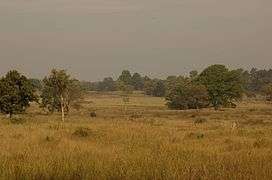 Meadows at Kanha
Meadows at Kanha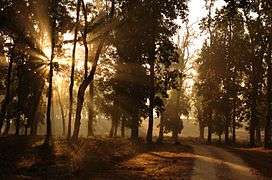 Open forest at Kanha
Open forest at Kanha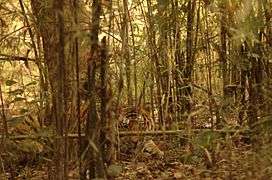 Tiger at Kanha hiding in bamboo
Tiger at Kanha hiding in bamboo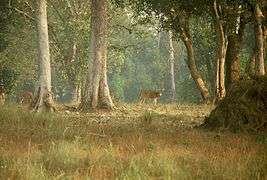 Axis in Kanha
Axis in Kanha
Fauna
Kanha Tiger Reserve has species of tigers, leopards, wild dogs, wild cats, foxes and jackals. Among the deer species, swamp deer (Cervus duavcelli branderi) or hard-ground barasingha is the pride of the place, as it is the only subspecies of swamp deer in India, except the great swamp deer of Sundarbans. The animal is adapted to hard ground unlike swamp deer of the north, which live in marshy swamps. The reserve has been instrumental in rescuing the swamp deer from extinction. Indian gaur (Bos guarus), belonging to the ox genus, are found in Kanha, but seen mostly as winter ends. In summer, gaur inhabit meadows and waterholes in the park.[7]
Other commonly seen animals in the park include the spotted deer, sambar, barking deer, and the four-horned antelope. The latter can be seen at Bamni Dadar climb. Recently, mouse deer have also been discovered in the tiger reserve.
Blackbuck have inexplicably become very rare.[8] They vanished completely, but have been reintroduced recently inside a fenced area in the park. Nilgai can still be seen near the Sarahi Gate, while the Indian wolf once commonly seen at Mocha is a rare sight now. Striped hyena and sloth bear are seen occasionally. Langurs and wild boars are common, but the pugnacious rhesus macaque is seen less often.
Nocturnal animals like fox, hyena, jungle cat, civets, porcupine, ratel or honey badger, and hares can be seen outside the park confines.
The reserve brings around 300 species of birds and the most commonly seen birds are the black ibis, bee-eaters, cattle egret, blossom-headed parakeets, pond herons, drongos, common teal, crested serpent eagle, grey hornbill, Indian roller, lesser adjutant, little grebes, lesser whistling teal, minivets, Malabar pied hornbill, woodpeckers, pigeon, paradise flycatchers, mynas, Indian peafowl, red junglefowl, red-wattled lapwing, steppe eagle, Tickell's blue flycatcher, white-eyed buzzard, white-breasted kingfisher, white-browed fantail, wood shrikes, and warblers, vultures among many more.[9][10]
Reptiles such as Indian pythons, Indian cobras, krait, rat snakes, vipers, keelbacks, and grass snakes are nocturnal animals, so rarely are seen. Many species of turtles and amphibians are found in or near the water bodies.
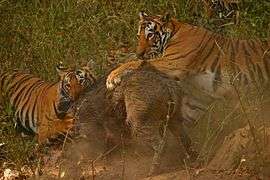 Tigers killing a wild boar
Tigers killing a wild boar- Kanha is most famous for its tigers.
 The gaur is the largest wild animal in the park.
The gaur is the largest wild animal in the park.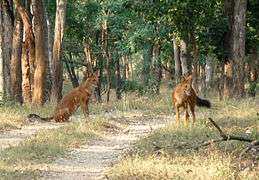 Two dholes at Kanha
Two dholes at Kanha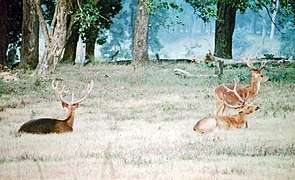 Kanha is the last refuge of the rare hard-ground barasingha.
Kanha is the last refuge of the rare hard-ground barasingha. A male hard-ground barasingha
A male hard-ground barasingha Pregnant tiger
Pregnant tiger
Reintroduction of barasingha
An exciting conservation effort in this national park is the reintroduction of barasingha. The gaur will be relocated to Bandhavgarh and some barasingha will be relocated to Satpura Tiger Reserve The objective of this project is to introduce about 500 barasingha in this national park to eight or nine different locations. There is also a project to capture about twenty tigers and relocate them to Satpura Tiger Reserve.[11]
Tiger conservation and the Baiga tribe
Members of the Baiga tribe, a semi-nomadic tribe of central India that is reliant on the forest, lived in 28 villages that had been within the Kanha National Park until 1968, when they were relocated. The relocation was part of an effort to maintain a critical tiger habitat.[12] The land to which they were relocated is barren and they now suffer from alcoholism and malnourishment, and beg to support themselves.[12] The last of the villages to be relocated for the tiger habitat is in the core zone of the Kanha Tiger Reserve.[12] The area is the ancestral home of the Gond and Baiga tribes. In January 2010, Baiga tribe were illegally evicted from the park without proper compensation from the government, according to Survival International.[13][14]
In its efforts to maintain and restore tiger habitats, WWF-India has worked to create corridors that support the tigers and their prey, thereby stabilizing the tiger population. This includes efforts to prevent loss of life or property of humans, reduce human dependency on the forest, and reduce retaliatory killings of tigers when people have experienced losses.[15]
However, Kanha's frontline staff continue to receive support, training and equipment from WWF, even as they carry out the eviction of the 22,000 residents who are to be forcibly resettled from tiger reserves in the region.
General information
Kanha Tiger Reserve is:
- Area: (core) 940 km2 (360 sq mi) [16]
- Terrain: sal and bamboo forests, plateaus, meadows and meandering streams
- Best season: February to June
- Morning visiting hours: 6:30 am to 11:00 am
- Evening visiting hours: 3:00 pm to 6:00 pm
- Closed: 1 July to 15 October
Transportation and access
The Jabalpur Airport (cvt|175|km}} / 04:30hrs) has direct flights to and from Delhi, Mumbai, Kolkata, Hyderabad, Pune, Belgaum and Bhopal, with AirIndia, SpiceJet and Indigo operating daily flights. Nagpur (Mukki {{cvt|240|km) and Raipur (Mukki 185 km (115 mi)) have other airports.
Jabalpur is major railway stations with train connectivity across India. From Jabalpur, the best way to travel is via Mandla, which has a tourist taxi service to the park, and one can reach up to Chiraidongri the newly added Broad Gauge station[17] via jabalpur, Nainpur railway route to enter national park through Kanha gate. In pre-planned journey one of shortest road route is Jabalpur-Bargi Dam-Ganhsor-Thanwar Dam-Chiraidongri-Kanha National Park. Other route Jabalpur to Mandla (via NH-30)-Chiraidongri- Kanha route is preferred when arrival permission is to be taken from National Park authority at Mandla. This National Park can also be approached from Raipur - Gandai - Malanjkhand - Baihar highway route via Mukki Gate to National Park. M.P. Tourism and Private owners has hotels, resorts near to Mukki Gate. Similar stay facilities is also available at Khatia and Kanha Gate.
There are three gates for entrance into the park. The Kanha/Kisli gate is best accessed from Jabalpur and stops at the village Khatia, inside the buffer area. The second gate is at Mukki and the third, most recently opened, gate is at Sarhi.[18]
Ecosystem valuation
An economic assessment study of Kanha Tiger Reserve estimated that the tiger reserve provides flow benefits worth 16.5 billion rupees (0.80 lakh / hectare) annually. Important ecosystem services from the tiger reserve include gene-pool protection (12.41 billion year), provisioning of water to downstream regions (558 million) and provisioning of fodder in buffer areas (546 million). Other services included recreation value (384 million), provision of habitat and refugia for wildlife (319 million) and sequestration of carbon (219 million).
See also
- Arid Forest Research Institute
References
- "Kanha Tiger Reserve". Madhya Pradesh Forest Department. Archived from the original on 10 March 2011. Retrieved 14 April 2010.
- "Kahna Tiger Reserve: History and origin (3rd slide)". Kahna Tiger Reserve. Archived from the original on 15 March 2015. Retrieved 21 March 2015.
- "On 'The Jungle Book' trail at Kanha National Park". DNA India. 18 April 2016. Retrieved 18 May 2017.
- Neeraj Santoshi (29 March 2017). "Meet 'Bhoorsingh the Barasingha': Kanha tiger reserve becomes first in India get official mascot". Hindustan Times. Retrieved 18 May 2017.
- "Kanha National Park". Reservation Portal Madhya Pradesh Forest Department. MPOnline Ltd., JV between MPSEDC of Govt. of Madhya Pradesh & TATA Consultancy Services. Retrieved 14 April 2010.
- "Destination to roam". www.gocentralindia.com. Retrieved 21 February 2020.
- "Flora in Kanha National Park | Wild Flowers at Kanha". Retrieved 21 February 2020.
- A. P. Dwivendi: Protected Areas of Madhya Pradesh, Government printing Press, Bhopal 2003
- "Bird Watching at Kanha National Park with 300 Avifauna Species". Kanha National Park. Retrieved 26 July 2019.
- "Kanha National Park and Tiger Reserve – Treasures of Wildlife". WILDLIFEZONES.COM. Retrieved 26 July 2019.
- sala Reintroduction of Barasingha: Kanha National Park – Satpura Tiger Reserve Archived 2013-07-21 at the Wayback Machine
- "Out of the Jungle: The Baigas - Sayantan Bera". Galli Magazine. Retrieved 21 March 2015.
- Survival International. "Tribespeople illegally evicted from 'Jungle Book' tiger reserve". survivalinternational.org. Retrieved 21 March 2015.
- "Kanha Tiger Reserve".
- "WWF India - WWF-India's work for tiger". wwfindia.org. Retrieved 21 March 2015.
- "Kanha National Park - Kanha: Tiger Reserve Area in MP - Madhya Pradesh(MP) TourisKanha National Park - Kanha: Tiger Reserve Area in MP". Madhya Pradesh(MP) Tourism. Retrieved 19 October 2018.
- Indian Railway
- "How to Reach Kanha National Park, Madhya Pradesh". Retrieved 21 February 2020.
Sources
- K.K.Gurung, Gopal awasthi & Raj Singh: Field Guide to the Mammals of the Indian Subcontinent, Academic Press, San Diego, ISBN 0-12-309350-3
External links
| Wikimedia Commons has media related to Kanha National Park. |
- Explore The Kanha National Park
- Official Site

- Safari Booking
- Kanha National Park Kanha tiger reserve india- Kanha National Park Madhya Pradesh is of the best national park india.